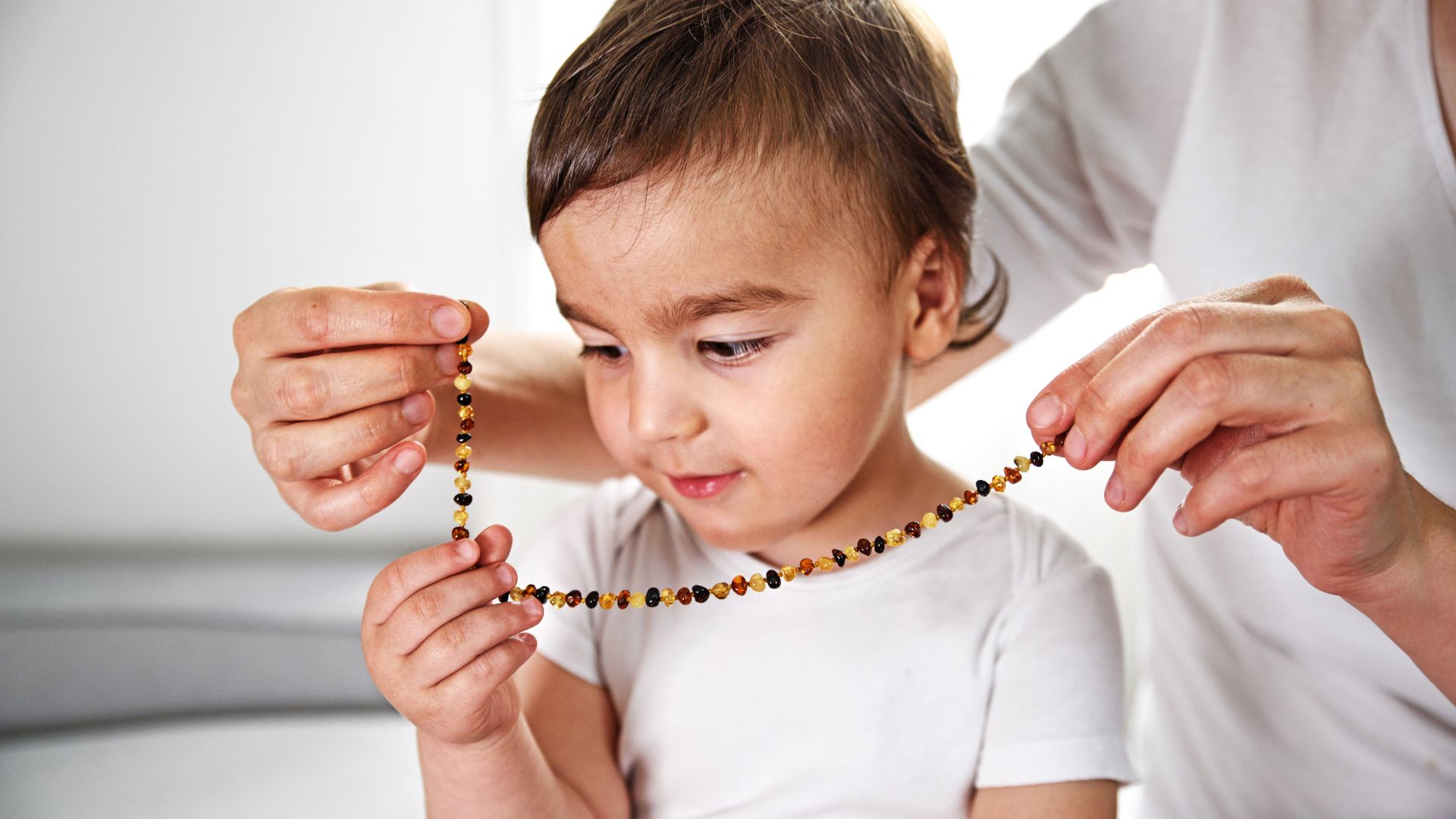Article originally published May 18, 2021
What parent has never felt helpless in the face of pain in their teething baby? Red cheeks and buttocks, swollen gums, fever, hectoliters of drool, diarrhea, grumpy child and calamitous nights, the times when babies come out are a real nightmare (word from a mother whose daughter has three premolars about to pierce ).
So, to try to appease your child, you may be tempted to do so resort to suggestions given by other parentsand in particular the famous amber necklace.
What is the amber necklace?
Amber is a fossil resin, secreted by a conifer that has now disappeared. Amber is collected from the bottom of the Baltic Sea. And this relatively rare yellow / orange colored resin has been used in jewelry for thousands of years.
For the followers of lithotherapy (a pseudoscience in which we heal ourselves with crystals), amber has anti-inflammatory properties and stimulates the immune system. The child does not need to chew the necklace, the simple contact of amber on the skin would be enough to release negative ions. (Don’t ask me what this is, I couldn’t find a scientifically satisfactory explanation).
Since at least the late 19th century, generations of parents have passed down this “amber necklace” trick as a miracle remedy for relieving teething babies. Here is what the pediatricians of the University Hospital of Toulouse and the Center Hospitalier de Montauban say in a study published in 2012 on teething necklaces in children:
“At that time, limited means of medicine and high infant mortality explained the use of religious or esoteric practices, particularly the use of teething necklaces.
However, the progress of science, medicine, anatomy and pharmacopoeia has not made us forget a certain number of popular beliefs and fears still deeply rooted among parents ”.
Is the amber necklace effective in case of baby teething?
Alas, no scientific studies have shown the efficacy of amber in relieving dental pain. If some parents have noticed their child’s pacification thanks to an amber necklace, the reason may simply be on the famous side. placebo effect.
Having the feeling that they have proposed a solution to their child who is suffering, parents are more relaxed, less stressed and helpless, and this calms the child. Conversely, stress and anxiety can amplify the perception of pain. (Source: my dentist).
In 2015, the Directorate General for Competition, Consumers and Fraud Prevention (DGCCRF) also sanctioned several retailers of amber necklaces for children for “Unjustified therapeutic claims”.
Investigators have shown that institutions propose antibacterial, antioxidant, anti-inflammatory or action on nerve impulses without supporting evidence that these claims have been provided. “
The risks posed by the amber necklace for children
Not only is the effectiveness of amber necklaces on teething not scientifically proven, but what’s more, it is certain that these can be dangerous for children.
Following numerous cases of infant deaththe U.S. Food and Drug Administration (FDA) even issued a warning in December 2018 for parents and early childhood professionals to warn them of the risk of strangulation and suffocation posed by “necklaces, bracelets or any other jewelry sold to relieve teething babies”.
Indeed, the necklace can be captured somewhere and cause the child to die by strangulation in a few minutes. It is therefore risky to put one around your neck, especially during sleep.
If the collar ever breaks, there is a risk of pearls ingestion and therefore suffocation of the child.
During its investigation, the DGCCRF verified the compliance of 32 bracelets and necklaces with the NF EN 71-1 standard, in order to ensure that the closure yields in case of traction (greater than 2.5 kg) to avoid the risk of strangulation, and that the thread of the necklace or bracelet resists a certain traction, so that it does not break and thus eliminates the risk of suffocation linked to the ingestion of pearls. Balance?
“Of 32 bracelets and necklaces sampled, 28 were considered dangerous due to a risk of strangulation or suffocation (87.5% of the samples). Most of these products are handcrafted in other European countries. The the quality therefore sometimes remains uneven (irregular pearls, type of thread) which implies being more attentive to this type of product which may have defects and therefore potential dangers. “
Worse still, half of the retailers didn’t show up no safety warnings about the risks of collars o the importance of parental supervision.
“One site, for example, sold bracelets without knots between each bead (the knots that allow you to limit the number of small items accessible in case of breakage) and without any safety notice. “
So, the amber necklace, do we buy it or not?
Well, well, we’re not going there for four routes. Given the real risks posed by amber necklaces and their scientifically unproven effectiveness, it’s better turning to other solutions to relieve the child’s dental pain. Or at least, only use it under close parental supervision, but frankly, the game isn’t worth the candle.
For reproduces the placebo effector, there are other harmless solutions such as homeopathy with the famous doses of Camilla. But even there, no scientifically proven therapeutic effects apart from our friend placebo.
If not, here are some tips collected by the health insurance website to ease the pain of your baby’s teething:
- Spin a teething ring your baby to chew. You can also put it in the refrigerator (the ring, not the baby), so that the cold will relieve it (the baby, not the ring). On the other hand, it is best to avoid going through the freezer, which risks injuring brittle gums.
- Scrub your gums with a previously washed finger or a clean cloth moistened with cold water. There are also finger-tipped caps for scrubbing treasure gums without losing a finger in the process. (Yes, as soon as there are teeth on top and bottom, any forays into the baby’s mouth are at your own risk.)
- Finally you can give your child cold dishes suitable for his age (compotes, yogurt) which can: 1) distract him from pain 2) cool his gums and do him good.
If your child has a fever and / or is having trouble tolerating pain, you can too administer paracetamol (respecting the formulation and dosage appropriate to the age and weight of the child and after reading the instructions in the box). Do not hesitate to consult a doctor if the fever exceeds 38.5 ° or if other symptoms appear.
The use of local anesthetic gels (type “Dolodent”) to rub on the gums is more controversial. Their compositions are not always great and can reduce the swallowing reflex that allows the baby to feed.
Avoid other grandma styling tips too: “you have to rub a sugar on the gum”. Yes, because sugar is not recommended for babies, and then why try to puncture the gum (with a sugar or something else) it is run the risk of injury (really) your baby and develop an infection. And a baby with the infection + teething combination takes you straight to the hardcore level of parenting.
And here it is: no purchase of an amber necklace = several tens of euros saved. Not at all ! See you at the next episode for a new episode ofScam or miracle?with more and more tips to save.
Photo credit image by to: FGorgun
Other episodes of
scam or miracle
-
Stop cutting out children’s tongues, warns the Academy of Medicine
-
Let’s take stock of neonatal frenectomy: big deal or good idea?
-
(Still) blocked by the crackdown on fraud, Wish will be dereferenced almost everywhere
-
Perineal massages in preparation for childbirth: useful or stupid?
-
The co-bed: essential for childcare or a hero gadget?
Source: Madmoizelle
Lloyd Grunewald is an author at “The Fashion Vibes”. He is a talented writer who focuses on bringing the latest entertainment-related news to his readers. With a deep understanding of the entertainment industry and a passion for writing, Lloyd delivers engaging articles that keep his readers informed and entertained.





